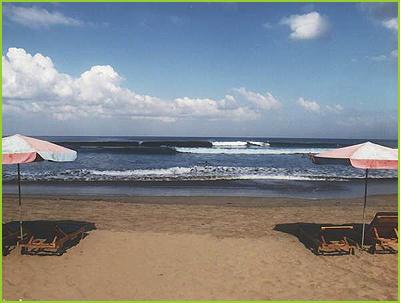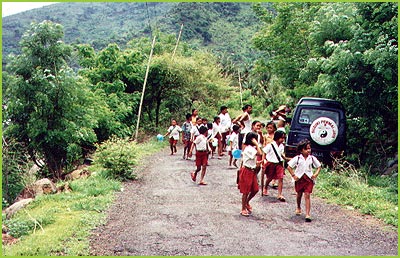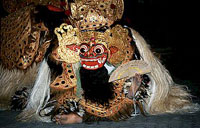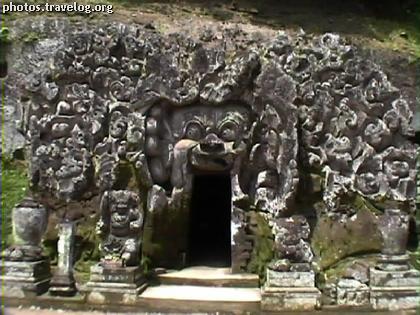Impressions of Bali

It's more than the typical beach vacation.
Many people from Europe and America travel a long distance to get to Bali. Most come for more than the usual tropical vacation under a palm tree. And they can get more in Bali - a rich cultural experience, friendly people, and a uniquely beautiful landscape.The top-level accommodations in Bali are famous for combining open-air casualness with an elegant style that includes fine carvings and lush gardens. Many wealthy people have adopted Bali architectural styles, like billionaire Richard Branson on his Caribbean island. For them, a Bali vacation can be as fine a holiday experience as can be found.
The other type of individual who flocks to Bali is the budget traveler, particularly those who can stay for a month or more. Since the terrorist bombing in 2002, hotel prices have dropped dramatically. It is not hard to find a good, beachfront room for $10 a night. As one man from Holland put it: "Bali is low cost paradise - once you have paid the airfare!" \

Kadek. my driver in Bali, invited me to spend some time at his village. His relatives there said I was brave to do this - and I agree. At first glance, the village was beautiful - ornate stone-carved entries, lush vegetation and flowers, all situated high on a ridge overlooking the terraced fields extending into the valley. Quickly I learned that the homes had no running water. Electricity was used only for the TV and some lights. Kitchen pavilions had no appliances - only smoky wood fires reminiscent of the Middle Ages.
The menu that evening was roast suckling pig. That meant slitting the throat of a squealing family porker, burning off his hair, then turning him on a wooden spit over coals for several hours. Neighbors came over to share in the feast. Mangy dogs scuttled after pieces of spit out gristle, while we scooped up rice and spicy vegetables with our right hands. (You don't want to know why the left hand is never used.)
The cut coconut at left was prepared by another person at the pool that day. Click for photos of his climbing the tree to get the nut and preparing it for drinking,

Somehow I got talked into spending the night at the village. The people certainly were friendly, and fascinated at the chance to look at an American close up, like the children at right. The next day there were ceremonies at the village temple, followed by cockfights at the same temple. The losing cocks had their heads cut off, and their feathers were being pulled even before all the winning money from the bets on their fight had been distributed. Later in the day, most of the village (including me) stepped down the long and steep trail to the river below - to bathe in the nude. Yes it all was earthy and basic. And I couldn't wait to get to a decent hotel.

Women's rights have yet to come to Bali. One moving moment for me at the village was watching a very old, half-naked woman struggling to hoist a huge basin of water to her head. Men never carry anything heavy if a woman is around. At the local school, girls are sent to the village tap to fetch water, but never the boys. I asked if a container with wheels might be used to help with water and other loads along the paved street, but the conservative men thought this wouldn't work.
At mealtimes, men always eat first, with the women in the background serving them or suckling infants. Women do most of the cleaning up. All this made me feel uncomfortable, but I got the impression that the women did not want to change the way things were. Certainly most seemed happier with their very interactive village life than many richer, but isolated American women. Many Bali wives watch over the family finances, even though they cannot control how much their husbands gamble at cockfights or spend on alcohol. Over half the men in the village smoked, while only an occasional older woman did. At least girls now are going to school. My driver's mother had no education and was married at age 14 to a 30 year old man. Yet today she is the one who runs the family wholesale foods business.

The best of Bali is in the rural uplands. Unlike other tropical islands, the people of Bali do not gravitate to the seacoast. Instead many live near the interior rivers, where they have carved out striking hillside terraces growing rice. Combined with dramatic volcanoes, the resulting natural and man-made scenery in traditional Bali is wonderful. The air in these higher elevations is cooler than at the coast, and wise travelers search it out.

Ubud is such an area. It offers ornate royal palaces and temples, exquisite dancing, fine wood and stonework, and water rafting - not your usual tropical sightseeing fare. I found near the center of Ubud a magnificent bungalow perched high above a leafy ravine and river. On the opposite side the front deck opened to an ornate private garden. $150 before the bombing, my price was only $22 a night, including full breakfast on either terrace. No other room at this boutique resort was occupied at the time.
Because of tourist interest in beaches, much recent building has taken place near the coast, particularly in south Bali. The result is a congested, slow traffic area in the South - far from the idyllic picture on Bali travel posters. Yes, the beaches at Kuta and nearby towns are quite nice, but the water is just as warm on less crowded shores. Tourists who spend all their time at south Bali beach resorts could have a similar vacation experience closer to home. And they are missing the unique beauty and culture that traditional Bali has to offer.

Bali culture stems from many sources. Let's take one example, the Goa Gajah (or Elephant Cave) near Ubud. This area of religious shrines shows several of the influences shaping Bali culture. It is likely that the first area of interest to worshipers was the nearby ravine and spring with large, unusual stones. Animist worship, as of the fern draped gushing spring, is still a part of religion practices in Bali.
Perhaps next developed on the site were the large ceremonial baths reminiscent of the baths in the center of Mohenjo-Daro, largest city in the first Indus River civilization (2500-1700 BC.) Ritual bathing was incorporated into the Hindu religion, established by Aryan invaders about 1500 BC. Later, traders from India brought the Hindu culture to Southeast Asia, including Bali.
The cave near the baths is thought to date from 1000 AD, and contains both Shiva (Hindu) and Buddhist statues. On the outside it has carvings that look like an elephant - not native to Bali. There is another Buddhist shrine nearby, plus an old Buddhist statue by spring. It is likely that Hindu and Buddhist missionaries purposely built close to the original nature worship area of the spring.
Arab traders later came to Indonesia, and converted all of the islands but Bali to Islam. Dutch traders came to Indonesia starting in the 1600's, but were not successful in transmitting their religion. Red tile roofs and Heineken beer seem to be the only Dutch legacies in Bali! American influence in Bali includes the Internet, movies, and rock music, but not religion. All these outside influences are examples of how history can be viewed as a succession of World Leadership Civilizations, a concept developed by Van Sloan and reviewed by Stanford's history department chairman.
Another Bali religious site that has been used more recently by a ruler is Pura Tirta Empul, a temple dating from 10th century. This temple incorporates sacred springs whose water is used to sanctify all new temples dedicated in Bali. In stark contrast to the old temple setting, on two hills right next to the temple, President Sukarno of Indonesia constructed a starkly modern, multi-million dollar mansion. It was as though President Reagan had built his vacation home on the hillside next to Old Faithful geyser in Yellowstone, replacing the trees with clipped lawn. Such a jarring note!
Go to:
Outline page of Exotic Beach VacationsComments to
: VanSloan@yahoo.com